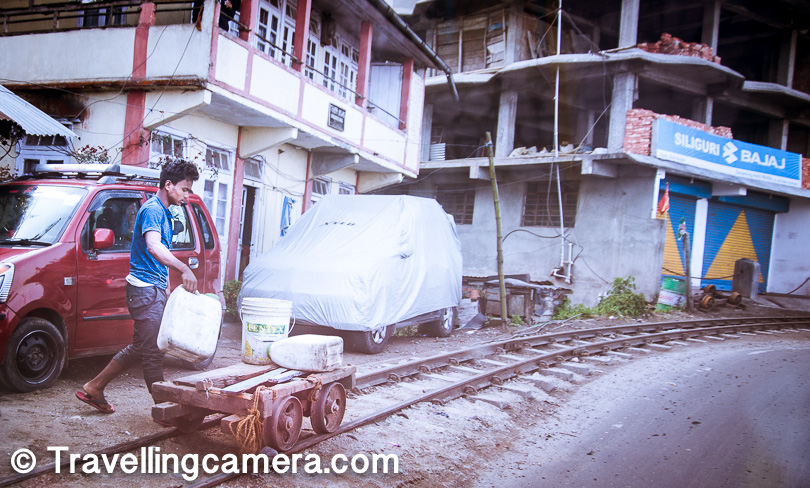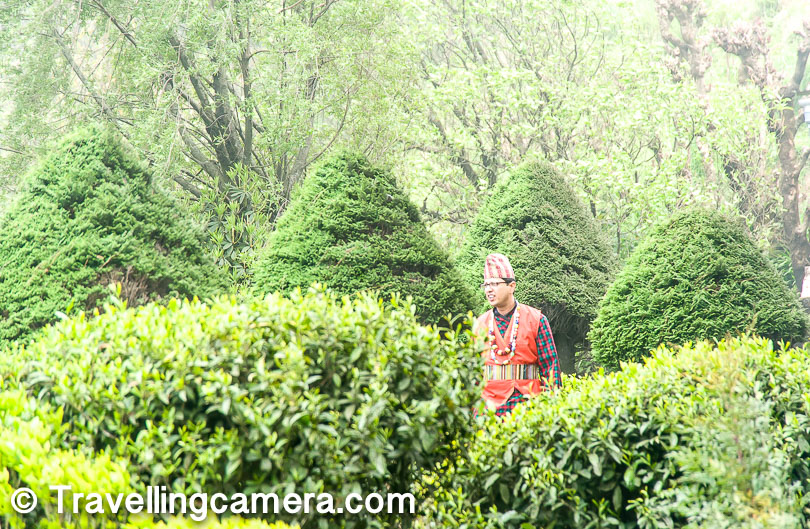The Darjeeling Himalayan Railway (DHR), also known as the "Toy Train", is one of the most famous relics of the British Colonization of India. This narrow-gauge (2ft) railway runs from Siliguri to Darjeeling, in West Bengal, covering a distance of 88kms and travels from an altitude of 100m in New Jalpaiguri to 2,200m in Darjeeling.
The railway is based on zig-zag and loop-line technology. The DHR has 6 zig-zags and 5 loops. The Zig-Zag technology is used by mountain railways to gain elevation without using tunnels. This technology is also known as the switchback technology. Basically, after covering one stretch of elevation, the train travels in reverse to cover the next stretch of elevation. It resumes the forward direction for the next stretch, hence traveling in a zig-zag manner, instead of going around the mountain or through a tunnel. The length of the train cannot be greater than the shortest stub track on the the zig-zag so that the train is able to successfully reverse here.
Related post - Breakfast at Glenary's || Exploring Darjeeling
Loop-line technology is used to ensure that faster trains are able to overtake slower trains on a route. Whenever a faster train approaches and needs to overtake another train, the slower train is moved to a secondary track, known as the loop line, and the faster train can overtake using the primary track. In this case too, the maximum length of the trains that can run on the route needs to less than the length of the loop line. As mentioned, Darjeeling Himalayan Railways has 5 such loops.
Related Post - Tiny Darts of Color || Vibrant Birds of Darjeeling
When the DHR was constructed in the late 19th century, it was driven by steam locomotives. Over the years, Diesel locomotives have mostly taken over the regular service, the tourist trains from Darjeeling to Ghum and the Steam Enthusiast Specials are still pulled by quaint little steam engines. These are vintage locomotives built by the British. A total of 34 of these B-Class locomotives were built by Sharp, Stewart and Company and the North British Locomotive Company from 1889 to 1925. However, only a handful of these are still in use. Nevertheless, the sight of these marvelous engines bellowing steam while traversing the streets of Dalhousie is fantastic.
The DHR follows the Hill Cart Road and often for long stretches the track runs alongside the road. The entire area is prone to landslides, especially during the rainy season. It was still summer when we were there, and yet it rained heavily almost everyday. However, despite the risk of landslides, it will probably be beautiful after the rains. I can imagine the clouds hanging over the valleys and the little train tearing through them to make its way towards the destination.
The journey from New Jalpaiguri to Darjeeling takes a little over 7 hours. This is the regular service that runs every day during the season and is pulled by Diesel Engines. However, the train often runs late. The train stops at 8 stations enroute, but there are stretches where the train moves so slow that it is possible to hop on and off the train while it is in motion. However, we do not advise that you do that.
Related Post - Darjeeling Zoo and its Exotic Animals
Apart from the regular long route, there are joyrides that are available between Darjeeling-Ghum-Darjeeling. The ticket prices are different for trains hauled by steam engines and those hauled by Diesel Engines, the ones hauled by steam engines being slightly more expensive. Apart from this, there is a Toy Train Jungle Safari which runs from Siliguri to Rangtong and back. This takes approximately 3 hours and is hauled by the Steam Engine.
Though the Toy Train Circuit was built to meet the transportation needs during the British Era, the journey has not lost its charm till date. This is probably the biggest tourist attraction in this region and even today, you need to book your seats days in advance, otherwise there are chances that you may not get a seat. A lot of energy and money is spent to maintain the trains, engines, and the tracks. But ultimately, we feel that it is worth it. In the year 1999, UNESCO made the Darjeeling Himalayan Railway a UNESCO World Heritage Site.
The Toy Train has also starred in several Bollywood movies. It is featured in the famous song "Mere Sapnon ki Rani" starring Rajesh Khanna and Sharmila Tagore. It also makes an appearance in the film Barfi, starring Priyanka Chopra and Ranbir Kapoor. Therefore, this little railway is also bit of a celebrity.
Even if we leave aside the Historical value and the Celebrity status, the sight of this little colorful train snaking along the road in Darjeeling is quite a treat especially when the weather is good and the hills are green. But if you want to experience a ride, you need to plan in advance. May be the entire journey from New Jalpaiguri to Darjeeling is too long, and we have heard that many coaches are not equipped with toilets too. So it may be more comfortable to book a joyride to experience this enchanting journey at least once.
If you are planning a trip - How to reach Darjeeling and main things to do around Darjeeling Hills










.jpg)
Comments